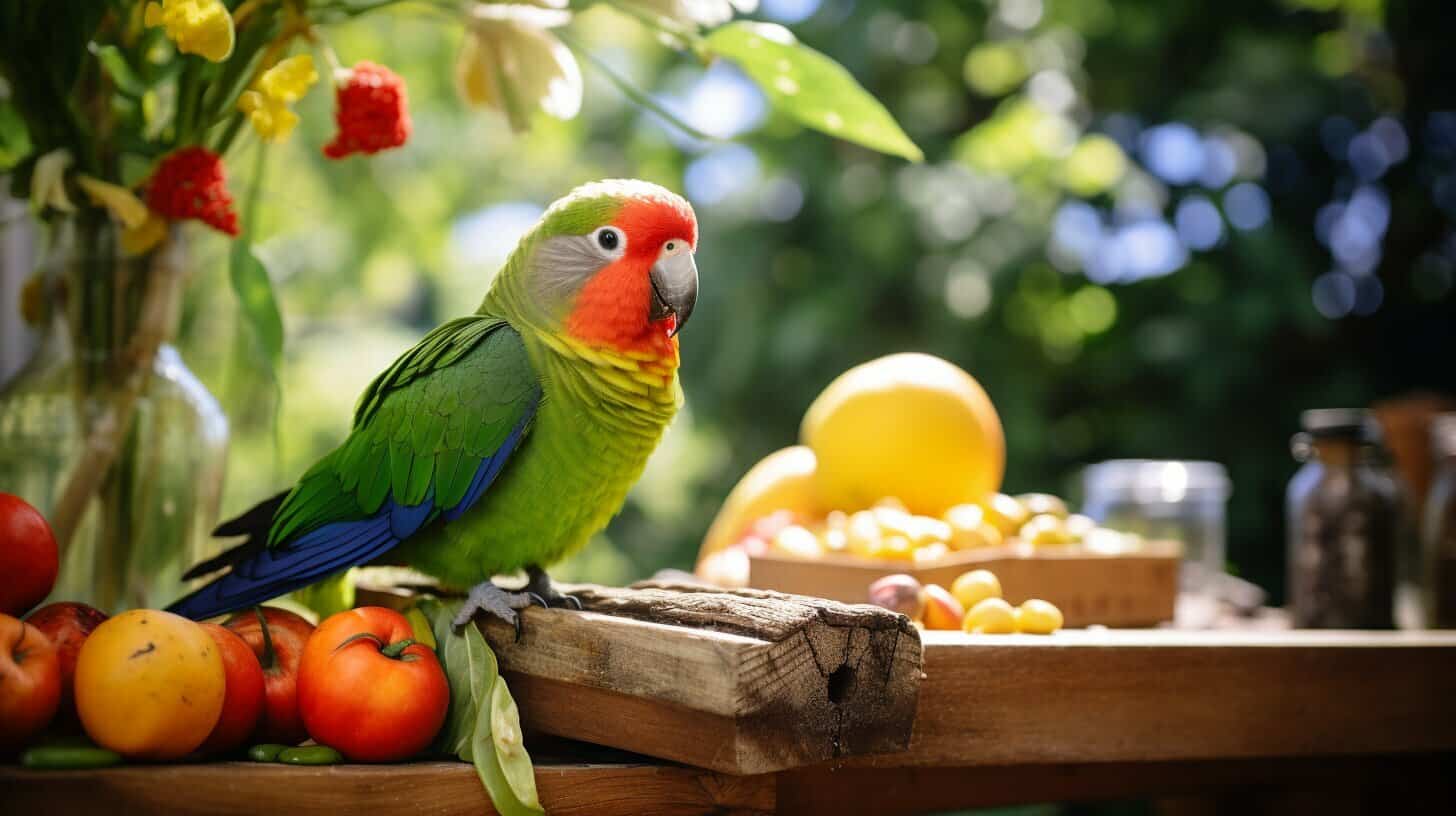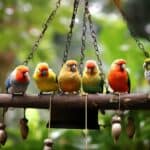Kakarikis are charming birds that are popular among bird enthusiasts. If you plan to breed Kakarikis, providing them with a balanced diet that meets their nutritional needs is crucial. This section will discuss the specific dietary requirements of breeding Kakarikis and provide tips for selecting the best food options.
So, what do you feed Kakarikis when breeding? Let’s find out!
Key Takeaways:
- Breeding Kakarikis requires a balanced diet that supports successful reproduction and healthy hatchlings.
- A high-quality seed mix forms the foundation of their diet, supplemented with fresh fruits and vegetables, protein-rich foods, and a source of calcium.
- Proper hydration, suitable nesting materials, appropriate environmental conditions, and regular monitoring of the birds’ health are additional essential considerations for breeding Kakarikis.
Understanding the Nutritional Needs of Breeding Kakarikis
Before selecting the best food options for breeding Kakarikis, it is essential to understand their nutritional needs. During the breeding phase, these birds require a balanced diet that provides the necessary nutrients for successful reproduction and the healthy development of their offspring.
Some of the key nutrients required by breeding Kakarikis include:
| Nutrient | Function | Food Sources |
|---|---|---|
| Protein | Supports egg production and the development of hatchlings | Cooked eggs, mealworms, and sprouted seeds |
| Calcium | Aids in eggshell formation and muscle function | Cuttlebone or calcium supplements |
| Vitamins and minerals | Support the overall health and development of breeding birds and their offspring | Fresh fruits and vegetables, high-quality seed mixes |
Providing breeding Kakarikis with a balanced diet that includes the right amount of these nutrients is essential for their overall health and successful reproduction.
Quality Seed Mix for Breeding Kakarikis
A high-quality seed mix is essential for the optimal diet of breeding Kakarikis. The seed mix is the foundation of their diet, and it should include a variety of nutritious seeds, such as sunflower seeds, millet, and oats. It’s crucial to check the freshness and quality of the seeds before offering them to your birds.
| Seed Type | Nutrition Information |
|---|---|
| Sunflower Seeds | Rich in healthy fats and protein to support egg production and healthy hatchlings. |
| Millet | High in carbohydrates and essential minerals such as magnesium and potassium, vital for healthy muscle and bone development in young Kakarikis. |
| Oats | They provide a good energy source and are rich in fibre, supporting healthy digestion and overall well-being. |
Offering a variety of seed types ensures your birds get a balanced diet. You can also add seeds to their diet that have extra benefits, such as flaxseed or chia seeds, which are high in omega-3 fatty acids. Ensure that your birds have access to fresh food at all times.
Fresh Fruits and Vegetables for Breeding Kakarikis
While seed mixes provide essential nutrients to breeding Kakarikis, they must supplement their diet with fresh fruits and vegetables. These foods provide additional vitamins and minerals that support the development of healthy offspring.
Some excellent options for fruits include apples, berries, and citrus fruits. Vegetables such as carrots, broccoli, and leafy greens are also great choices.
Before offering fruits and vegetables, ensure they are washed thoroughly and cut into appropriate sizes for easy consumption. It’s also important to avoid foods high in sugar or containing harmful substances such as avocado.
Protein-Rich Foods for Breeding Kakarikis
Protein is an essential nutrient for breeding Kakarikis, as it plays a vital role in supporting egg production and the development of healthy hatchlings. However, it’s crucial not to overdo it, as excessive protein can lead to health issues such as kidney problems. Here are some protein-rich food options to include in their diet:
| Food | Benefits | Notes |
|---|---|---|
| Cooked eggs | High in easily digestible protein and other nutrients such as vitamin D and choline | Soak seeds in water for 24 hours, rinse them thoroughly twice daily, and offer once sprouted. |
| Mealworms | Rich in protein and other nutrients such as calcium, iron, and B vitamins | Offer sparingly as a treat, as they can be high in fat |
| Sprouted seeds | High in protein, vitamins, and minerals | Soak seeds in water for 24 hours, rinse them thoroughly twice daily, and offer once sprouted |
It’s important to note that these protein-rich foods should not form the basis of a Kakariki’s diet. Instead, they should be offered in moderation alongside a balanced seed mix, fresh fruits and vegetables, and a source of calcium.
Calcium and Cuttlebone for Breeding Kakarikis
Calcium is a crucial nutrient for breeding Kakarikis, as it plays a vital role in eggshell formation and muscle function. Therefore, providing a reliable source of calcium to your breeding pairs is essential. One of the best sources of calcium is cuttlebone.
Cuttlebone is the internal shell of cuttlefish and is available at most pet stores. When offering cuttlebone to your birds, ensure that it is fresh and easily accessible for them to peck at. You can attach the cuttlebone to the cage wires or place it in a separate holder.
Other options for providing calcium include supplements that can be added to the bird’s water or food. It is crucial to follow the recommended dosage instructions when using calcium supplements and not to over-supplement, as it can lead to health issues.
Hydration and Fresh Water for Breeding Kakarikis
Proper hydration is essential for the health and well-being of breeding Kakarikis. These birds require constant fresh, clean water to stay hydrated and maintain their bodily functions.
Ensure you provide water in a suitable container easily accessible to the birds. To cater to their preferences, it’s best to offer water in different forms, such as in a bowl and through misting. Check the water source regularly to ensure it’s fresh and contaminant-free.
The amount of water that breeding Kakarikis require may vary depending on the climate and environmental conditions. It’s crucial to monitor their water intake and adjust it as necessary to prevent dehydration.
Additional Considerations for Breeding Kakarikis
In addition to providing a balanced and nutritious diet, there are a few more things to remember when breeding Kakarikis.
1. Nesting Materials: Breeding Kakarikis require suitable nesting materials such as shredded paper, coconut fibres, and dried grass. Ensure the nesting materials are clean and free from contaminants that could harm the birds or their offspring.
2. Suitable Environment: Breeding pairs of Kakarikis require a suitable environment with appropriate temperature and lighting conditions. Maintain the temperature at around 25°C and provide a light source for 12-14 hours daily. Ensure that the birds have sufficient space and privacy during their breeding phase.
3. Regular Monitoring: Monitor the breeding pairs’ health and behaviour. Watch out for signs of illness or aggression, and record the number of eggs laid. If any issues arise, seek advice from a veterinarian or an experienced breeder.
By considering these additional considerations, you can ensure that your breeding Kakarikis have the best possible chance of producing healthy hatchlings.
Conclusion
In conclusion, providing the right diet for breeding Kakarikis is crucial for successful reproduction and the healthy development of their offspring. Understanding their nutritional needs, offering a high-quality seed mix, supplementing with fresh fruits and vegetables, including protein-rich foods, providing a source of calcium, ensuring proper hydration, and taking additional considerations are essential for maintaining a healthy breeding environment.
Following the tips outlined in this article, you can ensure that your breeding Kakarikis receive the nutrients necessary for optimal health and successful reproduction. Remember to monitor their behaviour regularly and provide a suitable environment to create the best conditions for your birds’ breeding success.
FAQ
Q: What do you feed Kakarikis when breeding?
A: Kakarikis should have a balanced diet that meets their nutritional needs during breeding. This includes a high-quality seed mix, fresh fruits and vegetables, protein-rich foods, calcium sources, and ample hydration through fresh water.
Q: What are the nutritional needs of breeding Kakarikis?
A: Breeding Kakarikis requires a balanced diet that provides the necessary nutrients for successful reproduction and the healthy development of their offspring.
Q: What seed mix is suitable for breeding Kakarikis?
A: A high-quality seed mix with nutritious seeds such as sunflower, millet, and oats is ideal for breeding Kakarikis. It is important to ensure the freshness and quality of the seeds before offering them to the birds.
Q: What fruits and vegetables should be given to breeding Kakarikis?
A: Fresh fruits and vegetables, such as apples, carrots, broccoli, and leafy greens, should be offered as a supplement to the seed mix. These provide additional vitamins and minerals to support the breeding Kakarikis’ health.
Q: What protein-rich foods should be included in the diet of breeding Kakarikis?
A: Protein-rich foods like cooked eggs, mealworms, and sprouted seeds should be included to support egg production and the healthy development of hatchlings. However, excessive amounts of protein should be avoided to prevent health issues.
Q: How can calcium be provided to breeding Kakarikis?
A: Calcium can be provided through cuttlebone or calcium supplements. It is essential to ensure that the cuttlebone is fresh and easily accessible for the birds to peck at for their calcium needs.
Q: Why is hydration important for breeding Kakarikis?
A: Proper hydration is crucial for breeding Kakarikis. Fresh, clean water should be available at all times. Different forms of water provision, such as through a bowl and misting, can be considered to cater to the birds’ preferences.
Q: What additional considerations should be kept in mind when breeding Kakarikis?
A: Apart from their diet, additional considerations for breeding Kakarikis include providing nesting materials, maintaining a suitable environment with appropriate temperature and lighting, and regularly monitoring the health and behaviour of the breeding pairs.



Have comments or questions about this article? Then get involved!
Spotted an error or something we have missed? Let us know